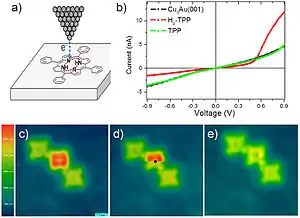
A unimolecular rectifier is a single organic molecule which functions as a rectifier (one-way conductor) of electric current. The idea was first proposed in 1974 by Arieh (later Ari) Aviram, then at IBM, and Mark Ratner, then at New York University.[2] Their publication was the first serious and concrete theoretical proposal in the new field of molecular electronics (UE). Based on the mesomeric effect of certain chemical compounds on organic molecules, a molecular rectifier was built by simulating the pn junction with the help of chemical compounds.
Their proposed rectifying molecule was designed so that electrical conduction within it would be favored from the electron-rich subunit or moiety (electron donor) to an electron-poor moiety (electron acceptor), but disfavored (by several electron volts) in the reverse direction.
Research
Many potential rectifying molecules were studied by the groups of Robert Melville Metzger, Charles A. Panetta, and Daniell L. Mattern (University of Mississippi) between 1981 and 1991, but were not tested successfully for conductivity.
This proposal was verified in two papers in 1990 and 1993 by the groups of John Roy Sambles (University of Exeter, UK) and Geoffrey Joseph Ashwell (Cranfield University now at the Lancaster University, UK), using a monolayer of hexadecylquinolinium tricyanoquinodimethanide sandwiched between dissimilar metal electrodes (magnesium and platinum)[3][4] and then confirmed in three papers in 1997 and 2001 by Metzger (now at the University of Alabama) and coworkers, who used identical metals (first aluminium, then gold).[5][6][7]
These papers use Langmuir-Blodgett monolayers (one molecule thick) with an estimated 1014 to 1015 molecules measured in parallel. About nine similar rectifiers of vastly different structure have been found by Metzger's group between 1997 and 2006.[8] Some more perylene based organic rectifiers with PEG (polyethylene glycol) swallowtails have been synthesized in Mattern's lab by Ramakrishna Samudrala.[9] These rectifiers would allow the rectification to be measured with flexibility.
Single molecules bonded covalently to gold have been studied by scanning tunneling spectroscopy and some of them are unimolecular rectifiers, studied as single molecules, as shown by the groups of Luping Yu (University of Chicago) and Ashwell (later at Lancaster University, UK).
Aims
The driving idea in UE (also called molecular-scale electronics) is that properly designed "electroactive" molecules, of between 1 and 3 nm in length, can supplant silicon-based devices to reduce circuit component sizes, providing concomitant increase in maximum integrated circuit speeds. However, amplification had not been realized as of 2012, and the chemical interactions between metal electrodes and molecules are complex.
References
- ↑ Zoldan, Vinícius Claudio; Faccio, Ricardo & Pasa, André Avelino (2015). "N and p type character of single molecule diodes". Scientific Reports. 5: 8350. Bibcode:2015NatSR...5E8350Z. doi:10.1038/srep08350. PMC 4322354. PMID 25666850.
- ↑ Aviram, Arieh; Ratner, Mark A. (1974). "Molecular rectifiers". Chemical Physics Letters. 29 (2): 277. Bibcode:1974CPL....29..277A. doi:10.1016/0009-2614(74)85031-1.
- ↑ Ashwell, G.J., Sambles, J.R., Martin, A.S., Parker, W.G. and Szablewski, M. (1990). "Rectifying characteristics of Mg|(C16H33-Q3CNQ LB film)|Pt structures". J. Chem. Soc. Chem. Commun. (19): 1374. doi:10.1039/C39900001374.
{{cite journal}}: CS1 maint: multiple names: authors list (link) - ↑ Martin, A.S., Sambles, J.R. and Ashwell, G.J. (1993). "Molecular rectifier". Phys. Rev. Lett. 70 (2): 218–221. Bibcode:1993PhRvL..70..218M. doi:10.1103/PhysRevLett.70.218. PMID 10053732.
{{cite journal}}: CS1 maint: multiple names: authors list (link) - ↑ Xu, T., Peterson, I.R., Lakshmikantham, M.V. and Metzger, R.M. (2001). "Rectification by a Monolayer of Hexadecylquinolinium Tricyanoquinodimethanide between Gold Electrodes". Angew. Chem. Int. Ed. 40 (9): 1749–1752. doi:10.1002/1521-3773(20010504)40:9<1749::AID-ANIE17490>3.0.CO;2-O. PMID 11353499.
{{cite journal}}: CS1 maint: multiple names: authors list (link) - ↑ Metzger, R.M.; Chen, B., Höpfner, U., Lakshmikantham, M.V., Guillaume, D, Kawai, T., Wu, X., Tachibana, H, Hughes, T.V., Sakurai, T.V., Baldwin, J.W., Hosch, C., Cava, M.P., Brehmer, L. and Ashwell, G.J. (1997). "Unimolecular Electrical Rectification in Hexadecylquinolinium Tricyanoquinodimethanide". J. Am. Chem. Soc. 119 (43): 10455–10466. doi:10.1021/ja971811e.
{{cite journal}}: CS1 maint: multiple names: authors list (link) - ↑ Metzger, R.M., Xu, T. and Peterson, I.R. (2001). "Electrical Rectification by a Monolayer of Hexadecylquinolinium Tricyanoquinodimethanide Measured between Macroscopic Gold Electrodes". J. Phys. Chem. B. 105 (30): 7280–7290. doi:10.1021/jp011084g.
{{cite journal}}: CS1 maint: multiple names: authors list (link) - ↑ Metzger, R.M. (2006). "Unimolecular rectifiers: Present status". Chem. Physics. 326 (1): 176–187. Bibcode:2006CP....326..176M. doi:10.1016/j.chemphys.2006.02.026.
- ↑ Samudrala, Ramakrishna (2008), Ph.D. thesis. University of Mississippi